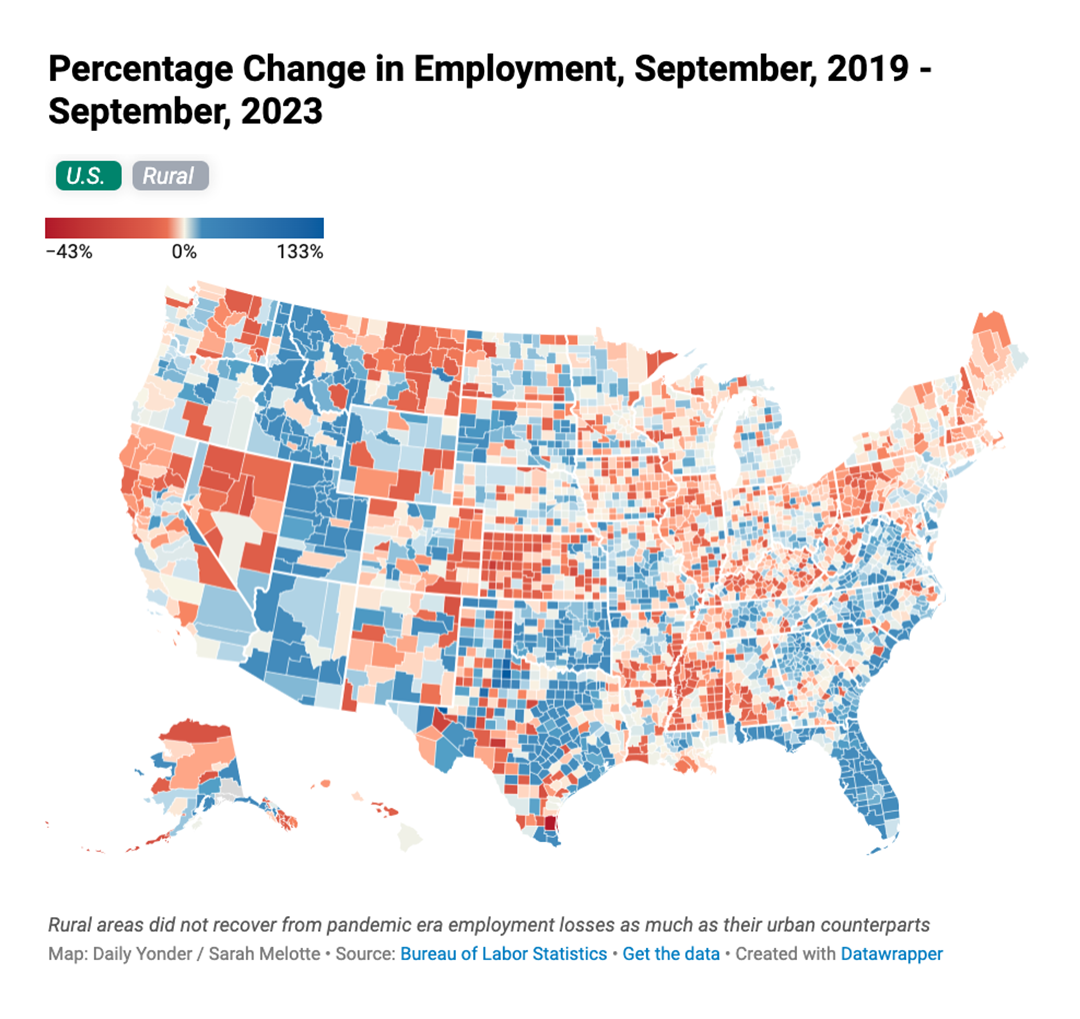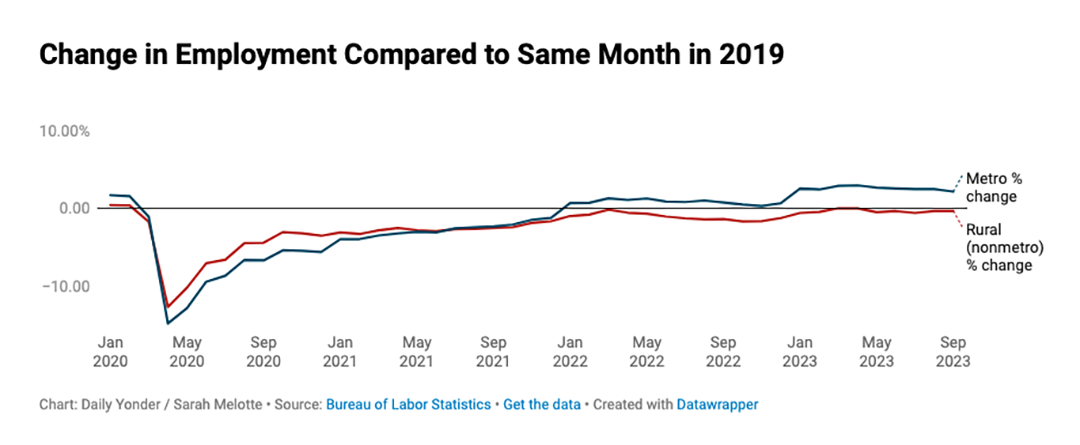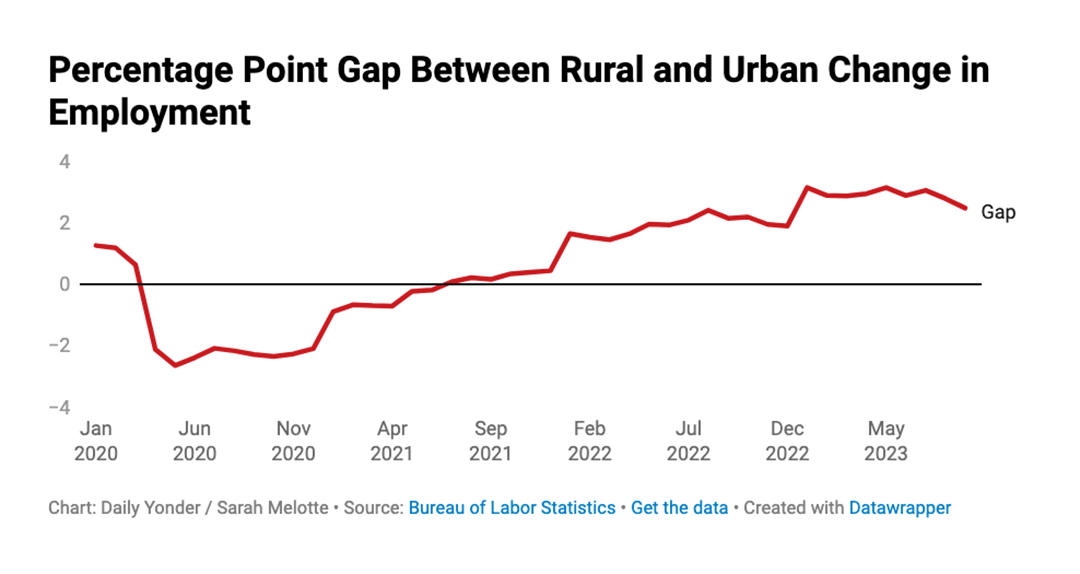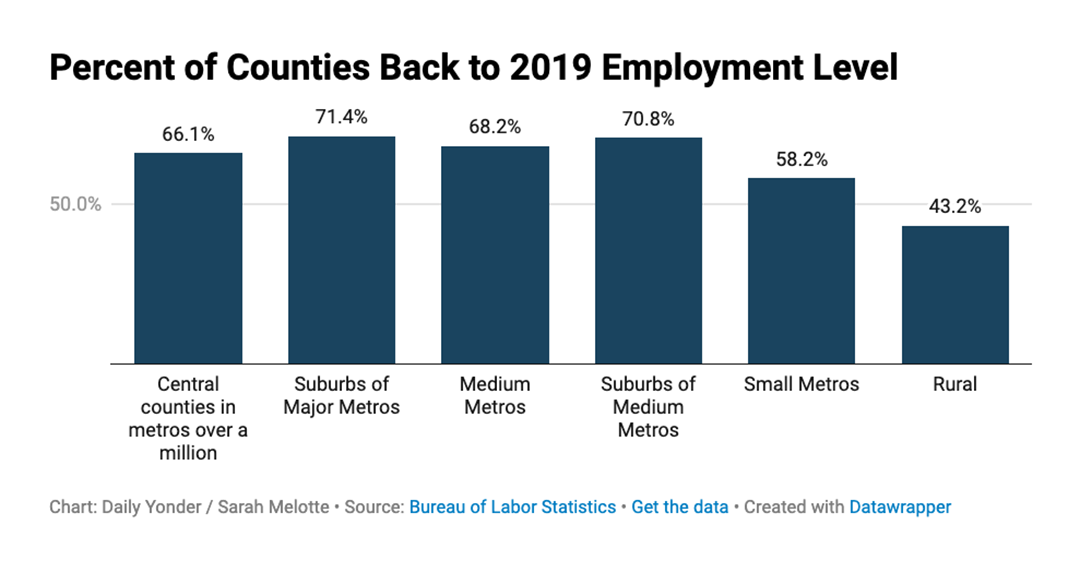Rural jobs grew a percentage point in September, but the longer-term trend is still a problem

Shutterstock
Rural jobs grew a percentage point in September, but the longer-term trend is still a problem
roadside “now hiring” sign
Rural America added more than 200,000 jobs over the past year but is still below pre-pandemic employment levels, according to a Daily Yonder analysis.
The failure to reach full recovery three and a half years after the start of the pandemic is related to larger trends, including an aging population, lack of childcare, and lower levels of formal education, according to an economist.
![]()

The Daily Yonder / Sarah Melotte
‘Rural areas took a hit’
Percentage Change in Employment, September 2019 – September 2023
Rural employment grew to 20.4 million in September 2023, the latest month for which county-level jobs data is available from the Bureau of Labor Statistics. That’s an increase of 1% from last year. But rural America still has 64,000 fewer jobs this year than it did the same time in 2019, before the pandemic.
Meanwhile, metropolitan counties have gained back more jobs than they lost during the pandemic.
“Rural areas took a hit,” said Elizabeth Davis, Ph.D., professor of applied economics at the University of Minnesota.
Rural counties haven’t fully recovered from the 2008 financial crisis, much less the drop in employment brought on by the pandemic, Davis said.
Every month, the BLS releases data on the number of employed and unemployed people for every county for the preceding 14 months. To take a look at longer employment trends, The Daily Yonder compared each month between January 2020 and September 2023 to the same month in 2019. The result gives a percentage change in employment from the last full year of pre-pandemic employment. Comparing the same months each year removes seasonal variations that affect employment.

The Daily Yonder / Sarah Melotte
Rural job recovery since the onset of the pandemic has not entirely happened
Change in Employment Compared to Same Month in 2019 – Chart: Daily Yonder / Sarah Melotte Source: Bureau of Labor Statistics
The graph above compares employment numbers beginning in January 2020 to employment numbers as of the same month in 2019. As can be seen, by September 2023, employment in urban areas grew by 2%, while rural areas decreased by 0.31%, compared to pre-pandemic employment.

The Daily Yonder / Sarah Melotte
Urban counties recovered faster than rural ones, but the gap is closing
line graph of Percentage Point Gap Between Rural and Urban Change in Employment
At the start of the pandemic in early 2020, rural counties initially didn’t suffer as much job loss as urban counties. Employment dropped 13% in April 2020 compared to 2019, while urban counties had a 15% decrease for the same period.
(This analysis uses the Office of Management and Budget (OMB) guidelines to categorize counties as either metropolitan or nonmetropolitan. The OMB metropolitan definition is based on the size of a city in the county and/or the commuting patterns of county residents. Counties not categorized as metropolitan are nonmetropolitan. This nonmetropolitan category stands as a proxy for rural.)
By May, employment nationwide began to recover. Rural counties were actually ahead of urban ones in employment recovery for the first year of the pandemic. After that, urban gains eclipsed rural gains in employment. The graph above shows how that gap widened noticeably in January 2022.
This graph shows a gap in recovery rates of rural and urban counties. Where the red line is below zero, rural areas were doing better than urban ones. When the red line is above zero, urban areas are doing better. During the second year of the pandemic, urban job recovery outpaced rural recovery by larger margins.
As of September of 2023 (the most recent data available), urban employment recovery was 2.5 percentage points higher than rural recovery.

The Daily Yonder / Sarah Melotte
Only 43% of rural counties have returned to pre-pandemic or better employment numbers, while about two-thirds of urban counties have
bar graph of Percent of Counties Back to 2019 Employment Level
If we break that analysis into different sizes of urban/metropolitan counties, we find that the suburbs of major and medium-sized metro areas did the best. Small metros (under 250,000 residents) were the worst-performing metropolitan counties. And rural/nonmetropolitan places were the least likely to have fully recovered.
Rural counties made up 95 of the top 100 counties with the most employment loss. Six percent (122) of rural counties have 10% fewer jobs now than they did in 2019, compared to only 0.7% of urban counties.
But the good news is that the rural/urban gap has been narrowing over the past few months. Five out of the nine months in 2023 saw a decrease in the disparity between rural and urban counties. The gap was 3 points in January, compared to 2.5 points in September of this year.
Possible factors: Lack of childcare, lower levels of formal education, older populations
Davis, the University of Minnesota professor, said it can be hard to generalize about rural employment because rural areas are so different from each other. But there are a few demographic factors she said might be at play in employment recovery.
“We hear a lot of employers concerned about the lack of childcare because they can’t find workers,” Davis said. “They hear from their workers and their families that they can’t find childcare so they can’t work, or can’t work full time.”
Davis said it’s challenging to sustain childcare centers in rural areas because the market is smaller. There may not be enough families with young children who can afford to pay for childcare to sustain such businesses. Lower wages and higher costs of transportation in rural areas can also affect household decisions about childcare.
A greater share of the rural population is also moving into retirement, which reduces the number of employed people.
“The aging of the workforce is happening faster in rural areas than urban areas,” Davis said.
The median age of the rural population is 43, compared to 36 for the urban population, according to the Census.
Not only are employers having trouble finding employees of working age who can afford childcare, but lower levels of formal education in rural America can also shrink the pool of potentially employable people.
Although education levels are on the rise in small towns and rural places, they still haven’t caught up with urban levels. Twenty-one percent of rural residents over the age of 25 have a bachelor’s degree, up from 15% in 2000. The share of the urban population with a bachelor’s degree increased from 26% to 36% during the same time period, which widened the gap between rural and urban education levels.
This story was produced by Daily Yonder and reviewed and distributed by Stacker Media.
